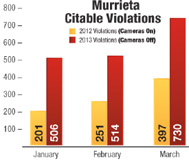4/16/2013
California: Firm Rigs Data In Bid To Keep Red Light CamerasAnalyst debunks claim that red light running increased in Murrieta, California when red light cameras were turned off.

Ever since November when voters in Murrieta, California rejected red light cameras at the ballot box, American Traffic Solutions (ATS) has been on a campaign to turn them back on. The strategy has been two-fold: use the courts to overturn the public's decision, then convince the city council to reactivate the devices in the name of public safety. Anti-camera activists say they have caught the photo ticketing company manipulating data to achieve these ends.
On April 5, Riverside County Superior Court Judge Daniel A. Ottolia signed a writ of mandate prohibiting Murrieta from implementing the anti-camera ballot measure. Ottolia is the same judge who attempted to block the public vote on August 3 (view ruling), only to be shot down by the Court of Appeal. To prevent the case from returning to the appellate judges, an ATS front group filed a separate suit against the city of Murrieta, which supports cameras, demanding the referendum be set aside. Despite the lack of an actual controversy between the parties, Ottolia issued his ruling accomplishing the goals of both ATS and the city.
Now it is up to the Murrieta City Council to decide whether to take the politically risky move of re-activating the red light cameras, which are no longer under contract. To sway council members, ATS issued a press release on Thursday with the bold claim that Murrieta's red light cameras recorded "nearly double the number" of "red light running events" after the cameras were turned off in comparison to the number of incidents when the cameras were active. According to ATS, there were 201 incidents in January 2012 compared to 506 a year later. In February, 251 incidents with cameras increased to 514 without cameras. In March, 397 with cameras rose to 730 without cameras.
"With cameras operational, drivers changed their behavior," ATS spokesman Charles Territo said in the statement. "This data shows just how much of a red-light running deterrent they were for drivers in Murrieta."
Safer Streets LA Executive Director Jay Beeber says the company is trying to pull a fast one. Beeber pulled the actual data from the city which showed ATS was taking its 2012 figures from a category called "Violations Citable." This does not represent the raw number of incidents. Rather, it is the number submitted to the city after an ATS employee has gone through and discarded images that are unclear and that otherwise cannot be turned into a citation. In February 2012, 263 such tickets were thrown out, meaning there were a total of 514 "Violations Recorded" in 2012 -- exactly the same number as recorded without the cameras in 2013.
Territo told the San Diego Union-Tribune on Monday that the photographic element of the camera system is shut down and the "violations" number comes solely from sensors. No employee has reviewed any images. Had ATS used the equivalent comparison of "Violations Recorded" in 2012 to 2013, the numbers work out to essentially a wash.
"One month was higher, one was lower, and one was exactly the same," Beeber explained. "The small differences could easily be due to random fluctuations or differences in traffic volume."
Anti-camera activists hope the company's effort to influence the city council with questionable numbers backfires.
"It is only through blatant deception that ATS is able to come up with their fraudulent 86.9 percent increase," Beeber said. "Make no mistake, this is not some accounting error on the part of ATS. It is obviously a deliberate attempt to deceive and we need to let the press know exactly what ATS is doing or they will take their bogus numbers and print the story without any fact checking."


